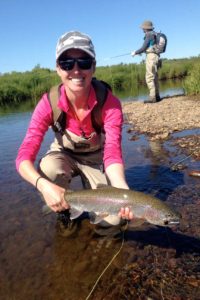Epic Blog
Seven Species Series: Rainbow Trout
07.20.20
Part Two: Rainbow Trout
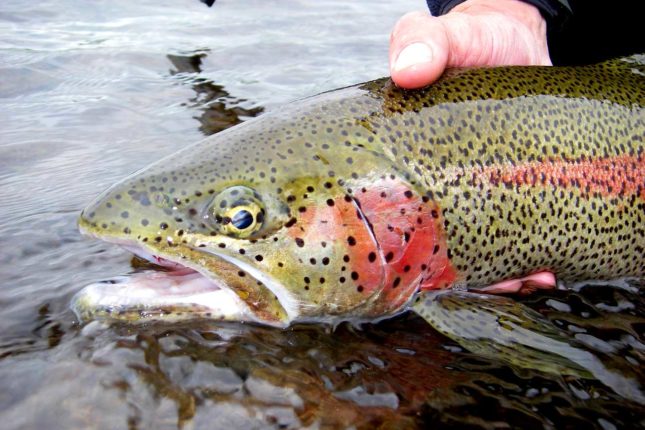
Some of the best fly fishing for rainbow trout on the planet is found in the Bristol Bay drainages of southwest Alaska.
It’s 2018, the end of June. Today we will welcome our first group of guests into our small tent camp. There will be four of them coming in from the frontier town of King Salmon; a hardscrabble hamlet consisting of a small commercial airport and a few businesses, its population made up mostly of pilots and fishermen. It’s built along the northern banks of the massive Naknek River. Looming to the south of town, across the wide river, is the whole of the Alaska Peninsula.
By mid day they have all arrived with their luggage and are eager to hurry through the introductions and camp tour to get their first taste of what they have all surely been thinking about for months on end, the promise of some of the best fly fishing that remains within the borders of the U.S. Now, after all of the planning and preparation, paradise is just a short distance away. And it is not hard for me to imagine, as one of their guides, what fish is most often on the forefront of their collective minds as I go about assisting them with gear and tackle. The Rainbow Trout.
A fine fish
This particular trout, who is a member of the Pacific Salmon family Oncorhynchus, is perhaps the most venerated of all freshwater fish. It is almost certainly one of the most widely distributed fish on Earth, having been exported around the globe from its native Pacific drainages to every far flung corner of the planet. Today it can be found on every continent with the exclusion of Antarctica. Considered by many to be one of the finest fighting fish to target on the fly, they have become synonymous with the sport itself. If you’ve ever hooked one it is immediately clear how this came to be. They are reckless, acrobatic, and completely unpredictable.
It doesn’t hurt that they are also stunningly beautiful. Their torsional bodies blushing with an iridescent array of colors that run from one end of the spectrum to the other. The hard freckles on their backs, fins and flanks read like some codified language that spells out the story of the last epoch, when the glaciers receded, and this perfect trout colonized the streams, creeks, and rivers from Northern Mexico to the Kamchatka Peninsula in Russia.
To the river

Most of the prolific trout fisheries in southwest Alaska are much larger, often unwadeable drainages. Our home water is perfectly sized for the wading fly fisherman.
We started our march under mixed skies in the early afternoon. From our camp you must first walk through a scrubby bramble of willow and fireweed along a well defined game trail. Soon you ascend a ridge and proceed to follow an even more well trodden trail that parallels the big river for as far as the eye can see. To the south, across what must be close to a to mile of open tundra, is our creek, invisible and hidden. I had two gentlemen with me, Mark and Bob. Mark is a veteran of both our camps, but he is especially an OUTPOST man, returning season after season. Bob, who is from the Great Plains, has never been to Alaska before. He has not done much fly fishing to speak of, but he is clear with me on our long walk to the water on one thing in particular:
“I wanna get one on a dry fly”
We march onward, making strange twists and turns in the vain attempt to negotiate the uneven ground. It’s honest hard work, and we all take a long breather once we make it to the final ridge that overlooks the creek below. Here another game trail guides us on a parallel course with the creek as we make our way downriver. Finally we scramble down a steep grassy hillside and enter a thicket of alder alongside an offshoot of the creeks main body. Mark, who is a genuine trout fanatic, is what I would describe as a self reliant angler. I only have to tie on a flesh mouse pattern of my own creation and give him the basic instruction that he is not to wonder too far ahead of us before unleashing him. I stick close to Bob, offering him an arm for the spots that are tough to wade. Finding pockets for him that are likely holding lies for an unsuspecting trout or grayling. The fishing is good. Better than good.
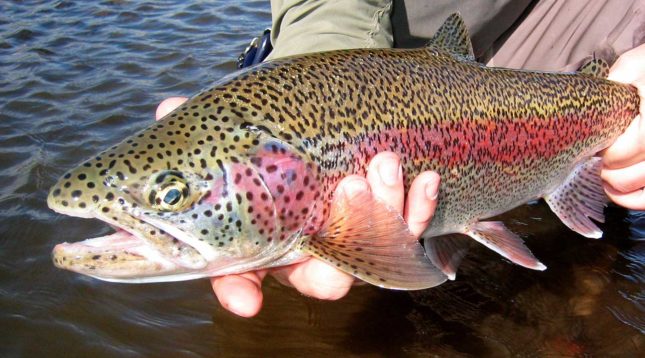
Stunning coloration and the aggressive, acrobatic fight of wild rainbow trout in southwest Alaska make an indelible impression.
Let’s try this one
Bob is astounded. He has probably caught more fish on a fly in his first hour then during the total of his previous experiences combined. Eventually we catch up with Mark at an oxbow bend where the water is deep. Usually this hole is a sure thing for salmon, but it is too early for them to be here now. Bob summons me to his side, and inquires, “What do you think of trying a dry fly here?” I look through my assortment of dries, scanning through the myriad of options, finally plucking the largest bi-visible Royal Wolfe I have in my box. “Let’s give this one a go.”
Leopards in Alaska
Before we proceed much further, a quick word on what makes the trout fishing at OUTPOST so unique.
First of all, Alaska is full of rainbow trout. They are natives here, and well ensconced in the folklore of Bristol Bay’s enumerable fisheries. Some, like the ones that live in the massive Naknek River, are lake run. They grow to be especially large and bare a striking resemblance to their anadromous counterparts (steelhead, a sea run rainbow trout) in physical appearance. Then you have the stream residents. These fish are colloquially referred to as Leopards, or Leopard Bows, due to the exaggerated heavy spotting that covers their entire bodies. Rather than migrating to and from a larger body of water like a lake, or making a trans-Pacific voyage in search of food, like a salmon or a steelhead, they remain near their birthplace.
This is the rainbow of our creek. A true native, who after spending another long and bleak sub-Arctic winter in its natal stream is more than eager to binge on proteins with reckless abandon. It is this scenario that creates a fly fishing extravaganza for the anglers that come to fish with us.
Of mice and trout
These trout are the mice eaters – opportunistic hunters that lie in wait ready to spring their ambush under every cut bank and deep corner. Typically, the earlier part of our season at OUTPOST is the zenith of trout fishing. This is when they have seen the least amount of pressure (from us) and also when the least amount of salmon have made their way into our creek. This seems to be the time when they are most susceptible to being taken on top. We have whole boxes full of large top water mouse patterns with enough foam tied in to ensure that you’re always in the game. I have seen trout charge a mouse pattern from half way across the river! They can be so undeterred that you will watch in awe as they miss half a dozen times but still come back for it, again and again. Of course this is the height of fishing, but like all fishing, it can vary, and it is not always the proverbial turkey shoot.
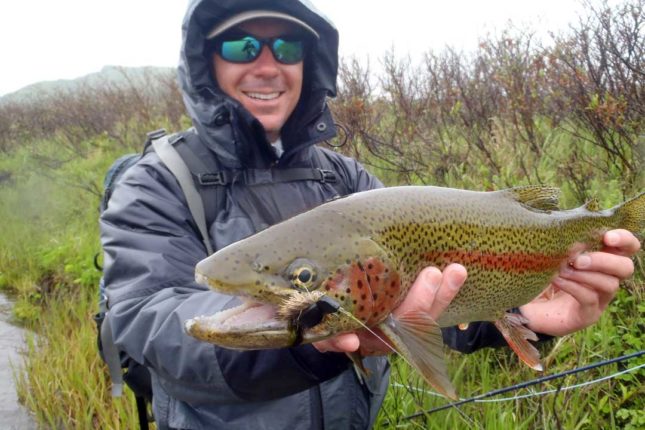
Catching a wild rainbow trout in Alaska on a mouse pattern, to most, is the pinnacle of fly fishing.
Normally, we are going to throw the big stuff at them. Whether it be a mouse or a streamer. This is trout fishing on steroids. Forget about that 4x tippet you brought up from back home. When we mouse for trout we typically run leaders anywhere from 16-20 pounds! And while it is true that a 5 wt is generally considered a perfect all around trout rod, I would always opt for the beefier 6 wt in this situation. Not so much for the size of the fish, which typically ranges in length anywhere from 14 – 22 inches, but for the size of the tackle. These fish are savage fighters, and when you fish a mouse, you are selectively searching for the most aggressive of them.
But it is not always about going big or going home. Sometimes we are traditionalist too.
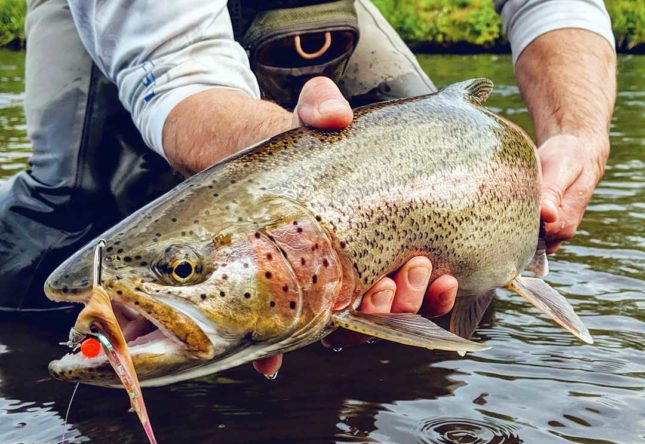
Streamers are commonly used targeting trout in southwest Alaska, but don’t forget egg imitations, mice and dry flies!
DID YOU SEE THAT!?
I rig Bob up with a fresh bit of 2x tippet to accommodate the size 8 Royal Wolfe I’ve just tied onto the end of his line. The first hour of the far north’s perpetual evening is upon us now. Mark and I stand back a few paces on dry land as Bob begins to feed out line and make his first series of false casts. The sun is directly in our eyes, but its light is soft and broken as it filters through the tall stalks of grass that grow on the high bank opposite us. I cannot remember how many times Bob presented his fly before it happened, it could not have been more than a few. I do remember that his fateful cast was a good one. His fly landed neatly on the far side of the creek and was riding true, its hackles skittering across the water’s edge. Its white bi-visible wings showing like a beacon against the inky black water that lay in shadow underneath the overhanging bank.
The tranquility of the moment was suddenly shattered by an explosion. What had just been a serene glassy pool perfectly reflecting the dimming sky above was now a tumult of radiating shock waves. The fish ran a short distance along the far bank and then jumped clear out of the water, flashing colors of deep greens and reds in a slow motion aerial display; revealing to all three of us in that infinitesimal moment of distorted time that this was not just some rainbow. This was a prize. This was a big fish!
It landed with a crash. Bobs line went limp. It had broken off. All fell silent again. Finally Bob turned towards Mark and I with a big grin on his face and said, “Did you see that!?”
One hundred times or more
I have a hundred memories of trout that were fooled by the mouse, so many now that it is hard to select one that stands out in my mind. I’ve seen days when the trout fishing was so good we all lost count before breaking for lunch. Perhaps Bob’s fish resonates with me because it not only fulfilled the old maxim in the world of angling that “you always remember the one that got away” but also because it escaped in such spectacular fashion. And that seemed fair to me then, as it does now. We call it fighting a fish, and every fight must come to its natural conclusions, have its winners and losers. Bob fought the good fight; it was the one he had wanted, the one he had been dreaming of, but the trout won in the end.
Stay tuned for the next chapter of this multi-part fish species series. Until then.
Written by Drew Griffith (aka “Machete”). June, 2020
Find more Machete articles here.
Posted in All Posts, Fishing, OUTPOST



